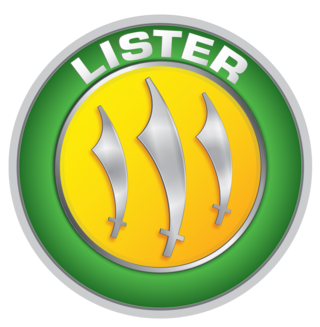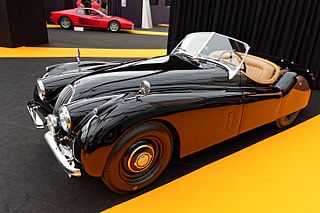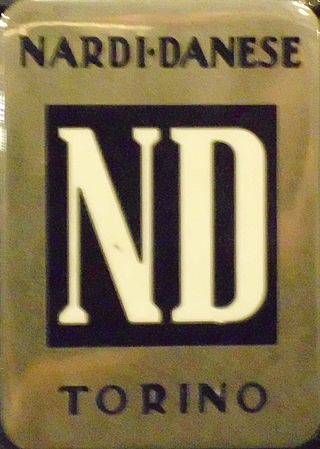
An open-wheel single-seater is a car with the wheels outside the car's main body, and usually having only one seat. Open-wheel cars contrast with street cars, sports cars, stock cars, and touring cars, which have their wheels below the body or inside fenders. Open-wheel cars are built both for road racing and oval track racing. Street-legal open-wheel cars, such as the Ariel Atom, are scarce as they are often impractical for everyday use.

AC Cars, originally incorporated as Auto Carriers Ltd., is a British specialist automobile manufacturer and one of the oldest independent car makers founded in Britain. As a result of bad financial conditions over the years, the company was renamed or liquidated many times until its present form. In 2022, the new corporate structure began the production of new AC Cobra models, with a slightly modified structure to adapt it to modern safety and technology requirements and obtain the European road homologation certificate.

The Porsche 804 is a single-seat, open-wheeled racing car produced by Porsche to compete in Formula One (F1). It raced for a single season in 1962 in the 1½ litre formula.

The Porsche 911 GT1 is a car designed and developed by German automobile manufacturer Porsche AG to compete in the GT1 class of sportscar racing, which also required a street-legal version for homologation purposes. The limited-production street-legal version developed as a result was named the 911 GT1 Straßenversion.

The Shelby Daytona Coupe is an American sports-coupé. It is related to the Shelby Cobra roadster, loosely based on its chassis and drive-train developed and built as an advanced evolution. It was engineered and purpose built for auto racing, specifically to take on Ferrari and its 250 GTO in the GT class. The original project had six Shelby Daytona Coupes built for racing purposes between 1964 and 1965, as Carroll Shelby was reassigned to the Ford GT40 project to compete at the 24 Hours of Le Mans, again to beat Ferrari in the highest level prototype class. With the Shelby Daytona, Shelby became the first American constructor to win a title on the international scene in the FIA International Championship for GT Manufacturers in 1965. The Shelby Daytona has recently been chosen for historic preservation as a significant vehicle in the history of auto racing.

The Jaguar D-Type is a sports racing car that was produced by Jaguar Cars Ltd. between 1954 and 1957. Designed specifically to win the Le Mans 24-hour race, it shared the straight-6 XK engine and many mechanical components with its C-Type predecessor. Its structure, however, was radically different, with innovative monocoque construction and slippery aerodynamics that integrated aviation technology, including in some examples a distinctive vertical stabilizer.

The 24 Hours of Le Mans is an endurance-focused sports car race held annually near the town of Le Mans, France. It is the world's oldest active endurance racing event. Unlike fixed-distance races whose winner is determined by minimum time, the 24 Hours of Le Mans is won by the car that covers the greatest distance in 24 hours. The cars on this track can go up to 366 km/h (227 mph), and in prior events reaching 405 km/h (252 mph) before track modifications. Racing teams must balance the demands of speed with the cars' ability to run for 24 hours without mechanical failure.

The MGA is a sports car that was produced by MG from 1955 until 1962.

The Ferrari250 Testa Rossa, or 250 TR, is a racing sports car built by Ferrari from 1957 to 1961. It was introduced at the end of the 1957 racing season in response to rule changes that enforced a maximum engine displacement of 3 litres for the 24 Hours of Le Mans and World Sports Car Championship races. The 250 TR was closely related to earlier Ferrari sports cars, sharing many key components with other 250 models and the 500 TR.

The Lister Motor Company Ltd. is a British sports car manufacturer founded by Brian Lister in 1954 in Cambridge, England, which became known for its involvement in motorsport. After buying the company in 1986, Laurence Pearce produced variants of the Jaguar XJS before producing a bespoke sports car, the Lister Storm. In 2013, Lister Cars was acquired by Lawrence Whittaker's company Warrantywise. Production of the original sports car restarted in 2014 and ten continuation Lister Jaguar Knobblys were built to celebrate Lister's 60th Anniversary. In 2016, the company announced the build and sale of the Lister Knobbly Stirling Moss. On 31 January 2018, the Lister LFT-666 based on the Jaguar F-Type was announced.

The Porsche 962 is a sports-prototype racing car built by Porsche as a replacement for the 956 and designed mainly to comply with IMSA's GTP regulations, although it would later compete in the European Group C formula as the 956 had. The 962 was introduced at the end of 1984, from which it quickly became successful through private owners while having a remarkably long-lived career, with some examples still proving competitive into the mid-1990s. The vehicle was later replaced by the Porsche WSC-95.

The Jaguar XK120 is a sports car manufactured by Jaguar between 1948 and 1954. It was Jaguar's first sports car since SS 100 production ended in 1939.

A Daytona Prototype is a type of sports prototype racing car developed specifically for the Grand American Road Racing Association's Rolex Sports Car Series as their top class of car, which replaced their main prototype racing class, specifically Le Mans Prototypes (LMPs). The cars later competed in the merged series of the WeatherTech SportsCar Championship, from 2014-2016, before being phased out and replaced by the Daytona Prototype International class in 2017. They are named after the main series event, the Rolex 24 at Daytona.

The Audi R8C is a Le Mans Prototype racecar that was built by Audi and designed by Peter Elleray to compete in the 1999 24 Hours of Le Mans under the LMGTP category. It was developed alongside the open Audi R8R LMP category spyder, prior to being replaced by the all-new Audi R8 in 2000.

Officine Nardi was an Italian automobile and racing car maker, named for their creator.

The Riley & Scott Mark III was a sports prototype auto racing car developed by Bob Riley, Bill Riley, and Mark Scott of Riley & Scott Cars Inc. Initially designed in 1993, the car was created for the World Sports Car (WSC) category which was to debut in the North American IMSA GT Championship during their 1994 season. It was not until 1995 that the first Mk III was completed, but the construction of further cars allowed a variety of teams to campaign in several North American and European racing series, including competing at the 24 Hours of Le Mans.
Établissements Monopole was a French manufacturing company that produced parts for automobile engines. The company also built and raced a series of small displacement endurance racing cars. After a series of mergers and acquisitions the Monopole name was retired in Europe, but survives in Africa in the name of a former licensee.
The B. S. Cunningham Company was an automobile company established by Briggs Cunningham. It produced six different models in very small numbers, primarily to be raced at the 24 Hours of Le Mans.

The Matra MS640 is a sports prototype race car, designed, developed, and built by the French manufacturer Matra in 1969. Two examples of this car were made: the original one from 1969 and the rebuild from 2005.

The Welter-Meunier P88 is a Group C sports prototype race car, designed, developed, and built by the French racing team Welter Racing, specifically to compete in the 24 Hours of Le Mans that year. It was designed and constructed according to the FIA's technical and sporting regulations for sports car racing.



















